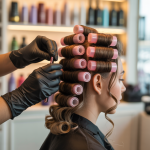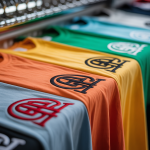Did you know that nearly 30% of women in the U.S. have tried a hair perm at some point? If you’re considering joining that statistic, it’s important to understand the ins and outs of hair perms. Knowing these basics can help you make an informed decision from the different types available to how they work. So, what exactly should you keep in mind before taking the plunge?
What Is a Hair Perm?
A hair perm is a chemical treatment that transforms straight hair into waves or curls, giving your locks a stylish boost.
If you’re considering a perm, it’s important to understand the different types of perms available. You might choose a classic perm for bouncy, tight curls or a body wave for soft, loose waves.
The perm solution used plays an important role in altering your hair texture, breaking down the protein structure of your strands. Depending on your hair texture, some perms may work better than others.
It’s crucial to consult with your stylist to determine which type of perm suits you best. You can enjoy beautiful, curly hair that enhances your overall look with the right choice.
The History of Hair Perms
Since the mid-20th century, hair perms have evolved considerably, reflecting changing beauty standards and technological advancements.
The history of hair perms dates back to the 1920s with traditional perms, which used heat and chemicals to create curls. As time went on, the perm process was refined, and different types of perms emerged, offering a variety of styles and textures.
Early perms relied heavily on harsh chemicals, but modern innovations introduced gentler options that still achieve stunning results.
Today, you can enjoy curls without the concern of damage that was often associated with older methods. Understanding the evolution of perms helps you appreciate the artistry and science that goes into creating beautiful, bouncy hair.
Different Types of Hair Perms
With the advancements in perm technology, you now have a range of options to choose from when considering a perm.
There are several different types of perms, each catering to unique styles and preferences. Common types of perms include the classic spiral perm, which creates tight curls, and the body wave perm, offering soft, loose waves.
Another popular option is the digital perm, which uses heat for a more natural look. When deciding on the type of perm you’re getting, think about your desired outcome and hair type.
The perm styles you choose can dramatically change your look, so consult with your stylist to find the perfect fit.
Whatever perm you choose, make sure it complements your style!

How a Hair Perm Works
When you get a hair perm, the process involves breaking and reforming the bonds in your hair’s structure.
During perming, specific chemicals are used to alter the protein bonds in your hair. These chemicals penetrate the hair shaft, allowing the hair to be reshaped.
After the bonds are broken, your stylist wraps your hair around rods to create the desired curl.
Once the hair is set in place, a neutralizing solution is applied to reform the bonds in their new shape.
This is what the perm creates: long-lasting curls or waves that enhance your hairstyle.
Understanding how the process works helps you appreciate the transformation and maintain your gorgeous new look.
Choosing the Right Perm for Your Hair Type
How can you choose the right perm for your hair type? First, assess your hair type—fine, medium, or coarse—as it influences how perm solutions interact with your strands.
For fine hair, soft waves or body waves are usually best; these common types add volume without overwhelming your locks.
If you have medium to coarse hair, tighter curls or spiral perms work best, giving you a bouncy, full look.
It’s crucial to consult with a stylist who understands which type of perm will suit your hair type and desired outcome.
They’ll help you figure out the right products and techniques to perm your hair while ensuring its health and integrity.
Choose wisely for the perfect result!
Preparing Your Hair for a Perm
After choosing the right perm for your hair type, preparing your hair is key to achieving the best results.
Start by ensuring your hair is healthy; this means avoiding harsh treatments or heat styling in the weeks leading up to your appointment.
Consider your hair’s current condition—if it’s dry or damaged, give it some extra TLC through deep conditioning treatments. Incorporate a gentle hair care routine that nourishes and strengthens your strands.
It’s crucial to cleanse your hair thoroughly before the perm; this removes product buildup that could damage your hair during the process.
Finally, avoid coloring your hair right before the perm, as this can lead to additional stress on your locks.
With proper preparation, you’ll set the stage for beautiful curls.
The Perming Process Explained
Understanding the perming process is essential to achieving those gorgeous curls you desire.
During the perm process, your stylist will wrap your hair around rods or curlers to create the desired shape. Once your hair is wrapped, they’ll apply a perm solution that penetrates your strands, breaking down the protein structure. This allows your hair to take on a new form.
After the appropriate processing time, the solution is rinsed out, and a neutralizer is applied to set the curls in place.
It’s vital to follow your stylist’s instructions for aftercare to maintain those beautiful curls. Remember, how well perms work depends on your hair type and the technique used, so trust your stylist’s expertise throughout the process.
Common Perm Techniques
Once you grasp the perming process, it’s time to explore the different techniques that can bring your curly vision to life.
One popular method is the spiral perm, where hair is wrapped around a perm rod vertically, creating tight, defined curls.
If you’re looking for a looser, more natural look, body wave perms offer soft waves that add volume and movement.
For targeted curls, a spot perm focuses on specific sections of your hair, allowing for customized results.
Finally, volumizing perms add extra lift at the roots, perfect for flat hair.
Each technique can transform your style, so consider what matches your desired outcome before diving in!
What to Expect After Getting a Perm
Getting a perm is just the beginning of your curly journey; you’ll want to know what to expect in the days and weeks that follow.
Initially, your hair will feel different due to the new texture of your hair. You might notice some slight frizz, and it’s important to be gentle to avoid perm damage.
Avoid straightening your hair for at least a few weeks after your perm, as your new curls need time to set.
To care for your hair, use sulfate-free shampoos and moisturizing conditioners, and consider using a leave-in conditioner to enhance your curls.
As you embrace your new look, remember that proper care will keep your curls looking vibrant and healthy.
Styling Tips for Permed Hair
With your new curls taking shape, it’s time to explore how to style permed hair for the best results.
First, consider the type of perm you’re getting; it influences your styling options. For soft waves, use a curl-enhancing cream and scrunch your hair gently. If you want defined curls, opt for a mousse and diffuse dry for volume.
Remember to take care of your hair by using sulfate-free shampoos and deep conditioning regularly.
Experiment with different curly hair styles, like loose updos or half-up styles, to showcase your beautiful curls.
Finally, don’t forget to accessorize! Hairpins or headbands can add flair while helping to keep your curls looking fabulous throughout the day.
Enjoy transforming your hair with these tips!
Maintenance for Permed Hair
Maintaining your permed hair is essential for keeping those curls looking vibrant and healthy. Start by washing your hair less frequently—aim for every three to four days. This helps prevent the drying effects of shampoo and maintains your curls.
When you do wash your hair, use a sulfate-free shampoo specifically designed for perm hair. After washing, gently pat your hair dry with a towel; avoid rubbing to reduce frizz and potential perm damage.
Additionally, use a wide-tooth comb to detangle your hair when it’s wet, and limit heat styling to avoid reverting to straight hair.
Regular trims every six to eight weeks also help maintain your curls’ shape and bounce. Follow these tips for effective maintenance of permed hair!
Products to Use on Permed Hair
To keep your permed hair looking its best, choosing the right products is key.
Start with a sulfate-free shampoo and conditioner specifically designed for permed hair; these help maintain your curl definition while minimizing damage.
Look for moisturizing products that nourish your hair, as perms can damage hair and lead to dryness.
Using a leave-in conditioner can add extra hydration and volume to your hair, giving your perm style a bouncy look.
If you have thinner hair, consider volumizing sprays or mousses that enhance your curls without weighing them down.
Finally, avoid heat styling tools whenever possible to preserve your beautiful waves and curls.
With the right products, your perm can look stunning and healthy for longer!
How Long Does a Perm Last?
How long can you expect your perm to last? Generally, perms can last anywhere from three to six months, depending on a few factors.
The type of perm you’re getting plays a significant role; for example, a digital perm might last longer than a traditional one. Additionally, how well you care for your hair after getting it permed can impact longevity.
As your hair grows, the roots will start to show your natural texture, which can affect the overall look of your perm. Remember, regular trims can help maintain the style and keep it looking fresh.
Risks and Considerations of Perming
While a perm can transform your hair into beautiful waves or curls, it’s important to be aware of the risks and considerations involved.
First, it’s necessary to understand that perms damage your hair, especially if you have fine or chemically treated strands. Different types of hair react differently, so knowing your hair’s health is crucial before proceeding. If you have healthy, strong hair, you may tolerate a perm better, but it’s still wise to consult a professional.
Additionally, consider the maintenance required; perms can be high-maintenance, and you’ll need specific products to keep your curls looking great. Assess your lifestyle and commitment to hair care before diving into perm uses to make sure you make the right decision for your hair.
Transitioning From a Perm to Natural Hair
If you’ve decided it’s time to shift from a perm back to your natural hair, you’re commencing on a journey that requires patience and care.
Changing from a perm to natural hair can be challenging, especially if your hair is damaged. Start by evaluating your hair length and the type of perm you’re getting; some styles may require more maintenance than others.
Focus on nurturing your hair with deep conditioning treatments to restore strength and moisture. As you grow out the perm, consider protective hairstyles that minimize breakage.
Frequently Asked Questions About Hair Perms
Wondering about the ins and outs of hair perms? You’re not alone! Many people have questions before deciding to get a perm.
First, consider the type of perm you’re getting—traditional, digital, or beach waves. Each creates different curly styles, so choose one that suits your look.
You might also wonder how long the results last; typically, a perm can last anywhere from three to six months. It’s essential to follow aftercare tips, like using sulfate-free shampoos, to maintain those beautiful curls.
Finally, if you’re concerned about hair damage, be sure to consult with your stylist about everything you need to know about perms, ensuring you make informed decisions for your hair’s health.
Celebrity Inspiration for Permed Hairstyles
Celebrities often set trends that inspire many of us to experiment with our looks, and permed hairstyles are no exception. From bouncy curls to relaxed beach wave perms, you can draw plenty of ideas from your favorite stars.
If you’ve got shorter hair, look to celebrities like Emma Stone or Miley Cyrus, who rock chic, textured styles that add volume and flair. For longer locks, think of the iconic Jennifer Aniston, who often sports soft, romantic waves.
With various types of perms available, you can easily find the perfect look that channels celebrity inspiration while fitting your style.
DIY Perm vs. Professional Perm
When considering a perm, you might be torn between a DIY approach and seeking the expertise of a professional stylist. A DIY perm can be tempting; it’s often more affordable and allows you to control the process.
However, it’s essential to remember that perms work best on healthy, strong hair. If your hair is damaged or weak, a professional perm is a safer solution for your hair.
Stylists understand the different types of perm you’re getting and can tailor the treatment to suit your needs. They also know how to minimize damage and achieve the desired look.
Ultimately, weigh your hair’s condition and your comfort level with chemicals when deciding between a DIY perm and a professional perm.

Final Thoughts on Hair Perms
Choosing to get a perm can be an exciting step toward transforming your look, but it’s vital to understand both the benefits and potential challenges involved.
Your final thoughts on hair perms should focus on the type of perm you’re getting and how it interacts with your hair’s texture. For instance, if you have coarser hair, a specific perm solution might work better for you than others.
Remember, the results may vary between the newly permed sections and the rest of your hair, so maintenance is key. Always consult with a professional stylist to guarantee you’re making informed decisions about the perm solution that suits your needs.
Embrace the change and enjoy your fabulous new waves!
Frequently Asked Questions
Can I Perm My Hair if It’s Colored?
Yes, you can perm your colored hair, but caution’s essential. Wait at least two weeks after coloring to allow your hair to recover. Consult a professional stylist to guarantee your hair remains healthy and vibrant.
How Often Can I Get a Perm?
Getting a perm’s like planting a garden; you can’t rush it. You should wait at least three to six months between perms. This gives your hair time to recover and maintain its health.
Will a Perm Damage My Hair?
Yes, a perm can damage your hair if not done properly or if you overdo it. It’s crucial to follow aftercare advice, use quality products, and give your hair time to recover between treatments.
Can I Swim With a New Perm?
Swimming with a new perm is like diving into a pool with a delicate cake; you risk ruining it. Wait at least 48 hours before swimming to let the chemicals fully set and protect your curls.
How Do I Reverse a Perm?
To reverse a perm, you can try a chemical relaxer or visit a professional stylist. You’ll need to assess your hair’s condition, as harsh treatments might cause damage. Always prioritize hair health over quick fixes.
Conclusion
In the world of hair, perms are like a magic wand that transforms your tresses into a cascade of curls or gentle waves. With the right knowledge and care, you can keep your hair looking vibrant and healthy, turning heads wherever you go. Whether you choose to visit a stylist or undertake a DIY adventure, remember that the journey to stunning curls is just as important as the destination. Embrace the change and let your hair dance!









